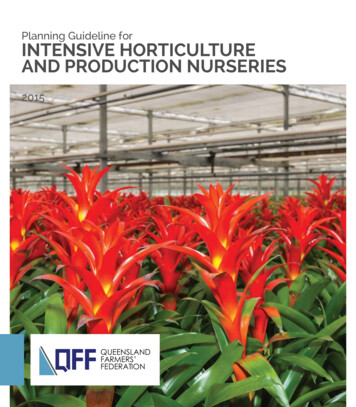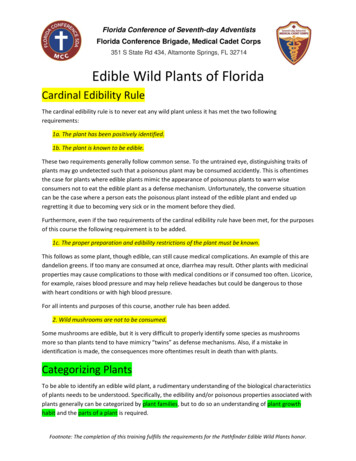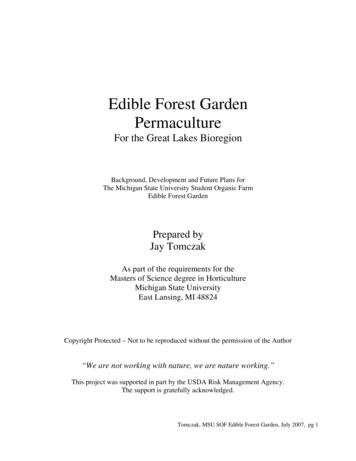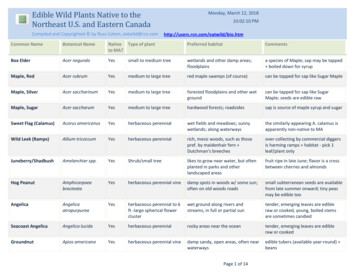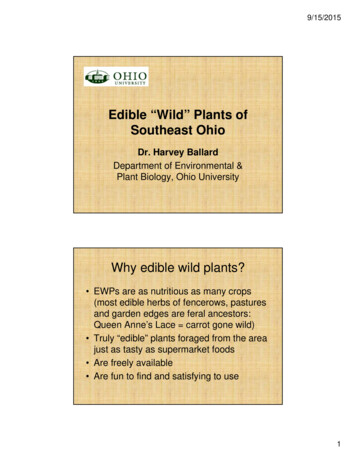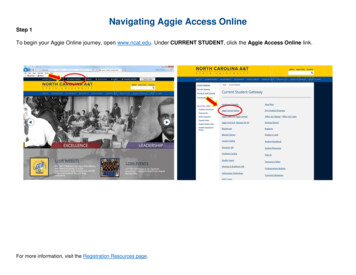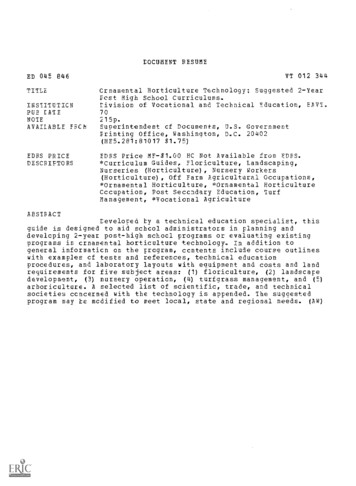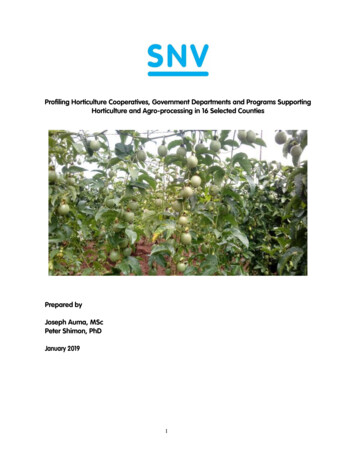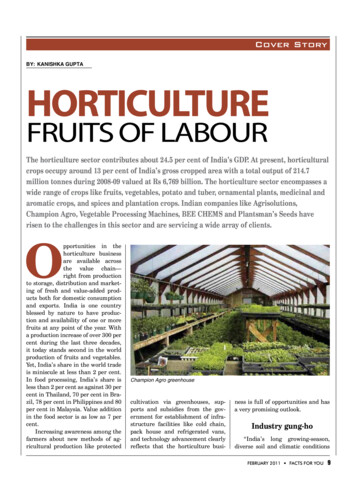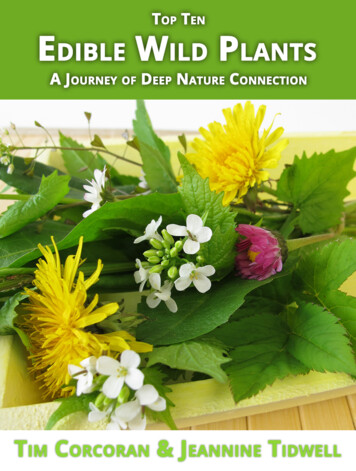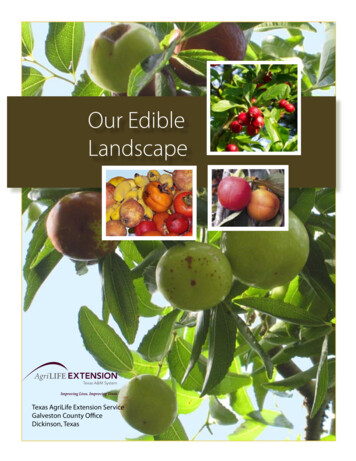
Transcription
Our EdibleLandscapeTexas AgriLife Extension ServiceGalveston County OfficeDickinson, Texas
Our EdibleLandscapeby Sam Powers, MG 1987(Aided and abetted by Ginger Powers)Other ContributorsAlcestis Cooky Oberg, MG 2002Margie Jenke, MG 2005Sandra Devall, MG 1998Herman Auer, MG 1983Texas AgriLife Extension ServiceGalveston County OfficeDickinson, Texas
Educational programs conductedby Texas AgriLife Extension Service serve people of all ages regardlessof socioeconomic level, race, color, sex, religion, disability or national origin.Appreciation is extended to Dr. William M. Johnson,Texas AgriLife Extension Service Galveston County Office-Horticulture,for his leadership and his technical adviceand review of this publication.All rights reserved.No part of this work covered by the copyright hereon may be reproduced or usedin any form or by any means without written permission from the Galveston County Master Gardener Association.
Table ofContentsPREFACECHAPTER 5INTRODUCTIONCHAPTER 1Jujube, the Chinese Date . . . . . . . . . . . . . . . . . . . 17CHAPTER 2Citrus. . . . . . . . . . . . . . . . . . . . . . . . . . . . . . 23CHAPTER 3More Great, Interesting, & Wonderful Fruit . . . . 31Eleagnus multiflora or GoumiFeijoa or Pineapple GuavaLoquatMayhawPersimmonPomegranateQuinceCHAPTER 4Common Fruits . . . . . . . . . . . . . . . . . . . . . . . . . . 45AppleFigNutsPeachPearPlumBerries and Grapes . . . . . . . . . . . . . . . . . . . . . . . . 59BlackberriesBlueberriesRaspberriesGrapesCHAPTER 6Greenhouse Tropical Fruit . . . . . . . . . . . . . . . . . . 67BananaKwai MukMangoMonstera or Split-leaf PhilodendronPapayaPitanga or Surinam CherryStar FruitCHAPTER 7Critters. . . . . . . . . . . . . . . . . . . . . . . . . . . . . . 77EPILOGUEBIBLIOGRAPHYTHE END
PHOTO CREDIT INFORMATIONThe photos in this book came from Galveston County Master Gardeners and our Master Gardener Photo Libraryand are not to be used without written permission.
PrefaceBY ALCESTIS ‘COOKY’ OBERGjube treesunding by tall juWindmill surroA delightful gardening teamembraces the new, the rare,and the exotic.When you go to Sam and Ginger Powers’ house in Arcadia Station (beside Santa Fe) Texas, you could literally live off the land.Any season of the year, there’s always something delicious to eatin the yard — loquats, blackberries, peaches, pears, figs, persimmons, jujubes, papayas, star fruit, bananas, pomegranates,monstera — and all kinds of citrus.Sam and Ginger are authorities on rare fruit trees, including jujubes and citrus hybrids. Their greenhouses contain specimen treesnot often seen outside the Amazon jungle, and their landscape isfull of fruit trees native to faraway lands around the globe.The Edible Landscape is the record of their hilarious and sometimes misbegotten experiences with growing exotic fruit in theirresidential landscape. It has been a gardening drama lived out onthe coastal plains of Texas for several decades, and is told in theirown lively words.
The Edible Landscape is an important horticulture book becauseit preserves the deep experience and wisdom of our local gardeningliving legends, Sam and Ginger Powers. Sam and Ginger are regardedas treasures among gardeners throughout our region, and receiverequests for information and advice from across the world. As aresult, preserving their rich experience and broad knowledge will givegardeners an invaluable play book of what can be grown here, how togrow it, what to do, and what to avoid doing.Persimmon tree that grew faster from bare rootMany citizens want to turn their yards into “edible landscapes”nowadays. They want to provide their families with healthy, homegrown fruit, free of pesticides and other chemicals. As a result of somany news stories about salmonella and e-coli contamination of storebought produce from abroad, a generation of “locovores” — peoplewho eat only locally grown produce — is arising. Also, gourmetswho have traveled widely and crave exotic fruits not usually found ingrocery stores would be interested in this publication.Sam and Ginger Powers are living proof that even an unlikelypatch of gumbo ground on the hot, humid, bug and critter infestedUpper Gulf Coast of Texas can become a year round cornucopia offruits from around the world.The Powers family has deep roots on that parcel of territory whimsically named “Arcadia Station”. Sam’s family bought this land inTexas in 1895, after reading brochures touting it as a tropical paradisewhere everything grew. “Pure hype,” notes Sam drily. Sam’s grandfather did indeed establish a robust citrus orchard, and shipped orangeseast by way of the nearby railroad as a commercial venture.It was not easy. He and his family survived the great and terrible 1900 storm, huddled behind a sand knoll outside their house,because the house was threatening to blow over and collapse uponthem. Despite the hard work and bravery, Sam’s grandfather’s losthis orange orchard to a hard freeze some years later. He truck farmedvegetables after that, and grew more cold hardy fruit trees — pearsand figs.Sam’s father was doing dairy farming on the family land when Samwas born there in 1930.He met his wife Ginger — raised in nearby Freeport, Texas — ata local college, and married her in 1956. They built their house byhand themselves on a 3½ acre parcel of the original Powers land— just in time for Hurricane Carla to hit in 1961. Fortunately, theyhad built it very well, and it didn’t get damage despite Carla’s 130mph winds and torrential rain.
Though they maintained little vegetable gardens over the yearsand their daughters raised rabbits that they showed at county fairs,Sam didn’t take up horticulture or agriculture until after he retiredfrom his job as a lab and instrument technician at Amoco Oil in1988. Sam’s friends — Arnold Lippert and Ted Teddlie — got himinvolved in the Galveston County Master Gardeners Association,and interested him into growing fruit trees. “What was I going todo in retirement anyway?” Sam says. “I couldn’t catch fish!”Sam and his friends went all over the region, collecting varietiesof different fruits as many enthusiasts do — by trading and grafting.Though Sam started some citrus trees from seed, he grafted most ofhis citrus trees on his grandfather’s hearty Trifoliata rootstock.During the hard freeze of 1989, most of Sam’s citrus trees werestill in pots, so he dragged them indoors. However, he and Gingerdecided it was wise to build two greenhouses to shelter their tropicaland citrus collection from another killing freeze like that.Through their many years of relentless experimentation withall kinds of fruit, they know which are the best performers — andwhich aren’t. They developed their own plum variety, named thePowers Plum, after years of experimenting with plum varieties. Theyare also often visited by citrus experts intent on grafting and hybridizing some of the rare trees in their greenhouse. Specialty nurseriesfrequently seek their advice and graftwood from their trees, andexperts from afar often trade cuttings and starts of newly discoveredvarieties with Sam.As for that 1895 brochure that assured land buyers they couldgrow anything in Arcadia Station, Texas — well, the kick is, it wasright, even prescient. In spite of the gumbo soil, violent hurricanes,hard freezes, severe droughts, voracious insects, hungry critters,and frequent floods, Sam and Ginger really have grown nearlyeverything in recent decades, and have made their patch of landtheir own little tropical paradise. Never resting on their laurels, thePowers are always charging off into raising many new exotic fruit— Kwai Muk, Jaboticaba, Grumichama, Strawberry Tree, and SugarApple — more often seen in the Brazilian Amazon jungle than inTexas.But to anyone who questions if something should be grown hereor not, Sam’s answer is simple: “Why not try?”Wedding Day - April 7, 1956
The bountiful crop10
IntroductionBY SAM POWERS, MG 1987Sam“Landscaping that might havegotten out of hand”This is going to sound odd but I do not consider the hundreds of fruittrees on my property to be an orchard. It is my idea of landscaping— that some people might consider to have gotten out of hand.How I Got StartedI took the Master Gardener course in 1987 (back in the stone age)and took early retirement in February of 1988. I gave myself a budgetof 100 a month to spend. My wife Ginger told me that there was noway I could stay within that budget. I hate to be told I can’t do something, but that limited what I could spend.I couldn’t have picked a better time to retire — dumb luck. I metTed Teddlie at a Galveston County Master Gardener meeting in 1987.He took me under his wing and educated me about growing fruit trees.He was a member of the North American Fruit Explorers (NAFEX),the Southern Fruit Fellowship, the Houston Garden club, the LakeJackson Men’s Garden Club, as well as Harris and Galveston CountyMaster Gardener Associations. He had just started a fruit and nut treestudy group that met at Bear Creek Park which I joined.11
The Gulf Coast Fruit Study GroupThe Gulf Coast Fruit Study Group was organized in 1987to promote interest in fruit crops for the Gulf Coast area.The concept was promoted by Bill Adams, then the Harris County Extension Agent, Dr. Leon Atlas — a medicaldoctor who for many years taught an annual lecture series onfruit tree cultivation and grafting techniques at the HoustonArboretum, and Ted Teddlie, who was inspired by his workwith the Harris County Master Gardener program. Theirgoal included the development of a demonstration orchardat the Texas AgriLife Extension Service Center in Bear CreekPark, so that interested homeowners could actually see andtaste the results of successful fruit and nut tree planting. Thestudy group would give a quarterly program at the ExtensionCenter attracting both amateur and professional lecturerswith special knowledge of fruit crops. They also hosted periodic excursions to local orchards, and distributed a newsletterto those interested in this field of knowledge. Subsequently,plant sales featuring fruit and nut trees were added to theagenda.ePath to our placAt the meetings, I met Dr. Leon Atlas, Dr. Ethan Natelson(a hematologist, and later editor of the group’s newsletter),Dr. Bob Randall (later director of Urban Harvest in Houston), and many other fascinating fruit experts too numerousto mention.sive operation. I had an enduring friendship with Heidi andBill from then on.After we left TreeSearch Farms, we made another detour tothe Harris County extension office. I was introduced to BillAdams and Tom LeRoy. Bill Adams was the Harris Countyhorticultural agent, famous for his weekly radio gardentalk show. Bill also was the author of many good gardeningbooks. Tom LeRoy was the Montgomery County horticulture agent, also an author of great gardening books includingGrowing Fruits and Nuts in the South: The Definitive Guide,which he coauthored with Bill Adams. They were both dedicated to popularizing the cultivation of home-grown fruitsand vegetables in the Houston area.The first newsletter was written by Ted Teddlie, starting in1987. Following Ted’s untimely death, Yvonne Gibbs editedthe newsletter, and more recently Dr. Ethan Natelson assumed the position.The Fruit Study Group still periodically meets at the BearCreek Park AgriLife Center. The demonstration orchard atBear Creek Park was named after Ted Teddlie.A Fateful DayTed Teddlie called one morning and asked if I would liketo go see a commercial tissue culture operation. He livedin Pasadena, Texas, about 30 miles away, and I told him Iwould be there in an hour. It turned out to be a very significant day for me. On the way to the plant tissue cultureplace, we made a slight detour and went by the now famous TreeSearch Farms specialty nursery before it officiallyopened for business. Ted introduced me to the owners, HeidiSheesley and Bill Rohde. Bill gave us a tour of what they hadaccomplished, and what they were going to do. Their goalwas to provide Houston with hard to get plants and trees,well adapted to the area. Bill especially wanted to push thefrontier of fruit tree culture in our region, finding new andwonderful varieties for home growers to try. It was an impres-After a tour of the Harris County gardens and orchards,we took off again. This time, we made it all the way to ourdestination. I had never seen a tissue culture business before.They had their stock plants in a small area close to the office,where we entered. All the plants were on metal tables withwheels set in tracks, so they could roll them from one endto the other. The left-hand row of tables were for the largerplants being hardened off before they were shipped out. Theyhad a pipe with misters and a roller on each end in a trackset up with a timer. Every five minutes or so, a fog started onthe far end. It came all the way down past the last table. Themisters turned off and the pipe rolled back to the far end.12
“Growing Fruits and Nutsin the South: The Definitive List”by Tom LeRoy & Bill AdamsJuju Tree in jumbo soilMy Way of Planting TreesThat day, they were starting bananas. There was a womanin a little open cubicle, sitting on a stool in front of a venthood with positive air pressure. She had on a face shield, alab coat, and gloves with a scalpel. She used a magnifyingglass to cut tiny pieces of the banana tree. She placed thetiny pieces in a test tube containing a liquid, and then sealedthe test tube. Different plants took different liquid blends.I asked about tissue culturing a plum tree, and was told itwould require a minimum order of 1,000 plants plus the costof developing a protocol for that plant, if there wasn’t onealready available. It was an interesting place — but it was wayout of my league. I wasn’t going to grow fruit commerciallyor on a large scale for sure.When I started to plant anything, a plant had to meettwo criteria: it had to be edible, and it had to be practicallymaintenance free. If a plant couldn’t survive the soil, the heat,the bugs, and the quirky weather on its own, it just died, andI would try something else.The soil in my yard is heavy black clay “gumbo” that isusually too wet or too dry to work. When it is wet, it sticksto your feet like molasses. When it is dry, it is like a rock.But that was the soil I had and the soil these trees had to dealwith. The only plants here that are not planted in gumbowere the roses and the blueberries which were grown in raisedbeds, and the grapes which were grown in fill sand.In subsequent weeks and months, Ted and I went tothe Lake Jackson Garden Club meetings where I met JohnPanzarella, a very influential citrus grower and hybridizer,along with many other knowledgeable plant people. It was apleasure to get to know Dr. Leon Atlas, who has a pear treevariety named after him, The Atlas Orient Pear. I took hiscourse on fruit trees, nut trees, and berries for growing inZone 9, our interesting climate.Most of my trees are planted in a small hole just largeenough to spread the roots. The hole is back-filled with thesame dirt (a method Texas A&M now recommends). AfterI dig the hole with a shovel, I take a spading fork and digor tear out another inch completely around the hole. Thisroughens the edge of the hole and breaks the glaze caused bythe shovel when the ground is moist. If the glaze is allowedto remain, it will dry and harden like a container. It would beas if you have planted the tree in a ceramic pot in the groundwithout drainage, and the roots cannot penetrate the wall.It was an intense education. I met many very knowledgeable and influential people in a very short time. I listenedvery intently and kept my mouth closed to keep from exposing my ignorance. I remembered that even a fish wouldn’t getcaught, if it kept its mouth shut.If the tree or shrub is potted when I buy it, I remove mostor all of the dirt in the pot from the roots of the plant beforeplacing the plant in the hole. I use the potting soil from13
Persimmon tree grew faster from bare rootthe pot as mulch on top of the ground around the plant.There’s a good reason for this. I had persimmon trees thatwere planted with the potting soil dirt attached 10 years ago— and they are just now starting to grow. Two or three treesare six feet tall, the others are not quite so large. On the otherhand, my 20 foot tall persimmon trees are only a year older,but were planted bare rooted.the end, and I installed an agitator kit to keep the materialin the tank mixed. I bought an extra spray gun that I couldextend the barrel to 6 feet. I also bought a 50 foot length of3 /8 inch tubing. We had a trailer with a rusted-out bed, so Icut it down and made the trailer to fit my spray rig. It doesn’tlook like much, but it cost less than half of what NorthernTools Company wants for their pretty rig without the extraspray gun and hose. With the 6 foot long spray gun and60 pounds of pressure, I can reach the top of any fruit treethat I have.So, planting bare-rooted trees in the ambient soil is thebest way to grow fruit trees, with a few exceptions.We put in an irrigation system for our peach trees, whichis discussed in that section.Small Spray RigsI had said that I was not going to spray the trees. That isnot completely true. I learned that when dormant oil wassprayed on while the tree was dormant, it would reduceinsect infestations. I occasionally spray streptomycin (Agromycin) on Ginger’s favorite pear tree to control fireblight.For years I enjoyed wrapping a kerosene-soaked rag arounda long poll and lighting the rag for webworms on fire. It wasvery satisfying to watch the web go up in flames. This ceasedto be an option when the trees became productive, and Ihad a half a dozen pears or persimmons almost ready to pickinside the web. From then on, I occasionally spray the fallwebworm nests with BT when they are on my fruit trees. TheBT does a great job on the webworms, but you must get itthrough both the outer web and inside part too, where theworms are feeding. If you just spray the foliage around theweb, you are taking a chance that the BT might be destroyedby the sun or washed off by the rain before the web expandsenough to include the sprayed foliage.I brought a new smaller spray rig a couple years ago. Itwas similar to what I had before with a bigger pump (60 PSIand 2 GPM). The tank is equipped with a clean-out plug onThe two greenhouses we built for our tropical fruits aredetailed in that chapter.With just these few pieces of equipment, simple plantingmethods, and practical attitudes, we were ready to plant justabout everything we wanted without driving ourselves crazy.Finally, be careful of what you read in books. Tom LeRoy,the Montgomery County Extension Agent, said that if youlive south of Interstate 10, ignore anything written by peopleliving north of Interstate 10. He’s right. It’s better to talk tolocal gardeners than to follow the advice of television gardeners and northern experts who are aimed at different regionswith different growing environments.14
General Tips To Watering Fruit Trees(and what won’t work) Every tree or bush planted in raised beds needsa lot more water that if it were planted in theground. If using organic mulch, pull the mulch back inseveral places to be sure the water is getting intothe ground and is not being absorbed only bythe mulch. It’s good to use a rod to check how deep the water has soaked into the ground. A ¼ inch deepwatering won’t help a tree. Soak newly planted trees weekly, and waterestablished trees every other week during adrought. Watch trees for signs of stress-drooping —wilted or dead leaves. Dig small holes aroundtrees to check for soil that is too wet or too dry. Watch for exotic and unusual plants’ reaction towatering. We had a paw paw tree that lost manyleaves every time we watered it with the irrigation pump. We plugged the water line, and itstopped losing its leaves. Soaker hoses don’t last long or work well if youhave sand or hard water. If you’re putting in an irrigation system, PVCblock valves seize up after exposure to sunlightfor a few months. You can’t open or close them.PVC gate valve handles disintegrate, too, andyou need a pliers to open or close them. Avoidthem. Don’t tell your spouse how to water trees afteryou finish your Master Gardener course. Everyone has their own method.15
16
Chapter 1GettingStartedwith Jujubes Produces fruit in 3 to 5 years after plantingJujubes Harvest fruit in August and SeptemberThe jujube would have to be my personal favorite fruit. Thisfruit tree grows wonderfully on the Upper Gulf Coast of Texas,is almost maintenance free, has no disease issues, and producesan abundance of great fruit. I highly recommend growing it toanyone that has some space for a tall tree in their yard.Getting Started With JujubesIf it is very dry the first year a jujube tree is planted, it may needan occasional watering. After the first year, the tree will survive onfive inches of rain a year. It will grow faster if it is watered occasionally during dry spells.Most varieties of jujubes start producing some fruit within threeyears of being planted. We have about 30 varieties and about 20 ofthose have produced some fruit so far. We have not had any disease,fungus, insect, bird, or critter problem. There is a wide variation intaste, production, and appearance among the different varieties.The two oldest trees are Lang and Sherwood. They are about25 years old. I weighed the fruit from the Lang for five consecutiveyears and the lowest production was 100 pounds, the highest about180 pounds. During the same period of time, the Sherwood hadfruit three years, about 20 pounds was the top production, and twoyears it didn’t have any fruit at all.17
I have carried most of the varieties to a taste tasting at BearCreek Park for the last three or four years and the varietiesA&M recommends are way down at the bottom off the listfor taste.The downside to the Jujube’s are that they are very thorny.For some reason, the number of thorns in some varietiesseemed to decrease as the tree ages.Most of the jujube rootstock send up lots of suckers, soyou could have a thorny thicket in a couple of years if youlet them go. But that’s a good thing. Roger Meyer, a tropicalfruit grower in California, digs up the suckers, tapes a grafton the top, and sells them for 30 for each two foot tall tree,plus shipping and handling. This was the price some yearsago.est jujubeLang - the largI bought graft wood from him for two dollars a stick anddid my own grafting on the suckers. The trees are not justproductive, but are also considered very ornamental forlandscaping. For example, the branches of the So jujube aretwisted and gnarled, and it is especially showy and sculpturalwhen it loses its leaves.Tricky HarvestThe fruit should be harvested early in the morning beforethe dew has had time to dry. The fruit is crisp if harvestedearly in the morning. If you wait until the afternoon, thefruit becomes pithy and tasteless. The next morning the fruitwill become crisp again. The texture of the fruit is improvedwith an occasional watering of the tree during a long dryspell.jujube varietiesThe easiest way to harvest the fruit is to spread a sheet ortarpaulin on the ground and shake the limbs. The fruit doesnot keep well after harvesting.Havesting JujubesAbout three weeks in the refrigerator is the maximum that I havebeen able to keep the fruit edible. But it’s worth it. The better tastingvarieties — So, Sugar Cane, and Chico — are hard to find and expensive to buy.18
Our Favorites – Jujubes!The flavor of the jujube will change from year to year,according to weather conditions. It’s best to eat them or usethem right away, since the don’t keep well.So and Sugar Cane are the sweetest and always win thetaste tests. Ginger’s favorite is the So and I like the Chico,which is not as sweet and has a slightly different sweet/tarttaste. Lang is the most productive. It tastes like an apple, butwe use it in cooking or dry it, rather than eat it fresh.ChicoSugar CaneSo19
SherwoodAnt AdmireJujube Varieties in order of size and productionLANG: Largest jujube. You must pick it before it is fully ripeto prevent spoilage, so pick slightly green before it turnsbrown. Best used for cooking and dehydrating. Makes excellent dried fruit, jujube butter, and will substitute for applesin a pie. Extremely productiveSILVER HILL: From Bear Creek Park.Same as Lang and may be the same tree.CHICO (GI 7-62): 2½ inch diameter 1½ inch high, excellent flavor, sweet, juicy, and crisp. Shaped like small a flattened pumpkin, a favorite at the taste tasting.Very productiveANT ADMIRE: Medium sized barrel shaped, sweet flavor.LI: Large size, fair taste, good for cooking or dehydrating.Production records incompleteSIHONG: Large, very good quality, barrel shaped fruit.SUGAR CANE: Ping pong ball size, dark red-brown when ripe,fruit has very sweet flavor, thorny tree.SO: Ping pong ball sized fruit, excellent flavor, dark red brownwhen ripe, attractive tree even without leaves.SWEET MEATY: Large marble sized fruit, extremely vigorous,productive thorny tree with sweet/tart fruit.Similar to if not the same fruit as is grown in IndiaSHU MIN: Large barrel shaped fruit, sweet with a slight pearflavor. Fair productionTsaoTIGER TOOTH: Fruit shaped like a large canine tooth,good fruit, ripens late.TSAO: The Oriental word for jujube, 1½ inches long and½ inch diameter, good flavor, ripens to dark color.Moderate productionSEPTEMBER LATE: Medium, sweet, barrel shaped.GI-1183: Medium, sweet, barrel shaped, sweet flavor.Moderate productionRussian #220
Tiger Tooth GallerySiohongGLOBE: Smaller round fruit, sweet flavor.MU: Old variety from China, 1920 import, new for me.Production records incompleteKOREAN #1: Large fruit, tart taste.Very productiveBURMESE SALAY ZEE THEE: Was an evergreen seedling,extremely thorny, reached out and hooked you 3 to 4 feetaway, bloomed in the fall, set fruit in the winter, and a lightfrost caused it to lose its fruit and leaves.Removed the treeHONEY JAR: Small fruit, very good tasting.Not very productive or healthySHERWOOD: Medium large fruit, barrel shaped, belowaverage taste, erect beautiful tree.Poor productionRUSSIAN #1: Large size, sweet taste.Production records incompleteGA-866: Medium sized fruit, supposed to have 42% sucrosebut mine had less sugar than most of the other varieties.Two trees have produced a dozen or so fruit in six years.Poor productionRUSSIAN #2: Medium to small size, sweet.Production records incompleteRUSSIAN #3: Large, sweet.Production records incompleteRUSSIAN #4: Large, sweet.Production records incompleteSeptember LateShui Men21
How To Dry Jujubesfrom GingerDried jujubes are delicious,like dried dates and dried figs. Pick the jujube fruit in the early morning. Wash and remove any stems. Discard any with soft spots. Place fruit in a large pot, and add water to cover. Place a plate on top of the fruit because it will floatif you don’t. Boil until just tender, and remove from heat tocool. Pour off liquid and rinse the fruit. Seeds can now be removed by using a ⅜ inch metaltube, about 2½ inches long. This instrument has tobe home made. Push the tube through the stem end. The seed willcome out the other end. Then slice the fruit in halfor you can also cut the fruit in two, and removethe seed by scooping it out. When fruit is properly halved, add ½ cup sugar toa quart of sliced fruit, and a ⅛ teaspoon cinnamon. Carefully stir this fruit/sugar/cinnamon mixture,and put it back on the stove on low heat untilsugar is melted and covers the fruit. Remove andlet cool. Place processed fruit on a rack and dehydrate atonce in a very low oven or in a dehydrator. If you don’t have time, refrigerate overnight anddehydrate the next day. The time this drying process will take depends on the size and you varietyof the jujubes. Do not over dry jujubes. They should be like softprunes. Place in quart plastic bags and freeze. They willkeep in the refrigerator a few days, but will mold ifleft out at room temperature for a long time. A treat - Toast a pecan & wrap a jujube around it.YUM!22
Chapter 2Citrusrs’ TrifoliaGrandpa Powete Orange TreeCitrus produces fruit in 10 years if grown from seed, two orthree years if planted from a pot to the ground, and one totwo years from a graft on a mature tree.Harvest fruit from October to March, depending on thetype and variety of citrus.When I first started playing with fruit and citrus trees in1988, it was mostly a trial and error experience — witha lot of errors with citrus. My grandfather had a citrusorchard on this property in the early 1900s. There were stilla couple of trifoliate orange trees across the fence at the backof our property when I started to grow citruses.A man in Houston was looking for some rootstock forcitrus, so I went to the back and dug up quite a few smalltrifoliate trees and put them in pots. He came down to pickup the trees and spent a couple hours grafting some citrustrees for me.They were still in pots and looking good — until the historically-cold freeze of 1989 struck. We moved all the citrustree pots onto the back porch, and wrapped the porch withplastic. As the temperature kept dropping, we moved thetrees indoors, into the den.We didn’t lose any trees. But there wasn’t any graft woodto re-graft the trees, if I needed to. So I decided to plant mytrees in a greenhouse.23
Mistakes in the GreenhouseFirst mistake: The citrus greenhouse we constructed was 15 feetwide x 45 feet long x 12 feet tall. I planted a dozen citrus trees inthe greenhouse — each one a different variety — and had plentyroom for more. The next mistake I made was to prune off the lowerlimbs and branches, so I could keep the weeds and grass down. Thismade the trees grow taller. Three or four of the trees set fruit in oneyear. It was then I realized just how much fruit all those trees wouldproduce. There was enough fruit for four families from four tr
The first newsletter was written by Ted Teddlie, starting in 1987. Following Ted's untimely death, Yvonne Gibbs edited the newsletter, and more recently Dr. Ethan Natelson as-sumed the position. The Fruit Study Group still periodically meets at the Bear Creek Park AgriLife Center. The demonstration orchard at

